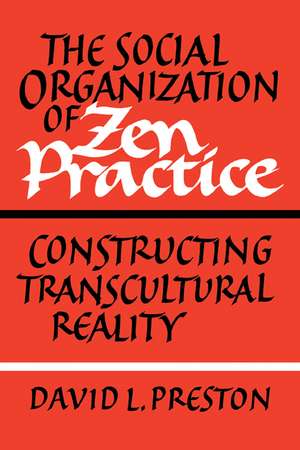The Social Organization of Zen Practice: Constructing Transcultural Reality
Autor David L. Prestonen Limba Engleză Paperback – 25 ian 2012
| Toate formatele și edițiile | Preț | Express |
|---|---|---|
| Paperback (1) | 280.74 lei 6-8 săpt. | |
| Cambridge University Press – 25 ian 2012 | 280.74 lei 6-8 săpt. | |
| Hardback (1) | 435.67 lei 6-8 săpt. | |
| Cambridge University Press – 23 iun 1988 | 435.67 lei 6-8 săpt. |
Preț: 280.74 lei
Nou
Puncte Express: 421
Preț estimativ în valută:
53.73€ • 55.50$ • 44.71£
53.73€ • 55.50$ • 44.71£
Carte tipărită la comandă
Livrare economică 25 martie-08 aprilie
Preluare comenzi: 021 569.72.76
Specificații
ISBN-13: 9780521183987
ISBN-10: 0521183987
Pagini: 190
Dimensiuni: 152 x 229 x 11 mm
Greutate: 0.29 kg
Editura: Cambridge University Press
Colecția Cambridge University Press
Locul publicării:Cambridge, United Kingdom
ISBN-10: 0521183987
Pagini: 190
Dimensiuni: 152 x 229 x 11 mm
Greutate: 0.29 kg
Editura: Cambridge University Press
Colecția Cambridge University Press
Locul publicării:Cambridge, United Kingdom
Cuprins
Foreword Randall Collins; Preface; Part I. A Sociological View of Zen: 1. Approaching the study of religion; 2. On going native; Part II. A Profile of Zen Membership and Formal Orgainzation in Southern California: 3. A profile of Zen membership; 4. The physical layout of a Zen center; 5. Formal organization and staff; Part III. The Zen Teacher: 6. The teacher; 7. Daily schedule; 8. Interaction with students; Part IV. What is Zen?: 9. Learning about Zen; 10. Varieties of Zen practice; 11. Zen viewed sociologically; 12. Zen practice; Part V. Meditation as a Social Phenomenon: I: 13. Becoming a Zen practitioner; 14. Consequences of meditative practice; 15. Becker's model; Part VI. Meditation as a Social Phenomenon II: 16. The social constructionist view; 17. Meditation defined; 18. Some consequences of meditative practice; Part VII. Doing Zen Meditation: 19. Sudnow's view of improvised conduct; 20. Using Sudnow to see Zen practice sociologically; 21. The social organization of Zen meditation; 22. Problems in Zen practice; 23. An experience of sitting meditation; Part VIII. The Social Organization of Zen Meditative Ritual Practice and its Consequences: 24. Bourdieu's concept of habitus; 25. Ritual, self-transformation, and reality construction; Part IX. The Meanings of Zen Practice: 26. Subjective (conscious) meaning; 27. Objective (unconscious) meaning; Part X. Summary and Conclusions; Appendix; Notes; References; Index.
Descriere
This book, first published in 1998, provides both a first-hand account and a theoretical analysis of the way an American Zen community works.














